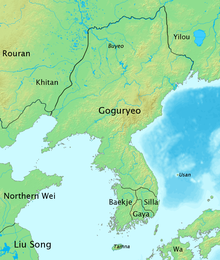Three Kingdoms of Korea
period of Korean history (1st century BCE – 7th century CE), where three kingdoms (Goguryeo, Baekje, and Silla) coexisted on the Korean peninsula
The Three Kingdoms of Korea were Goguryeo, Baekje and Silla. They existed between the 1st century BC and 7th century CE. There were some smaller kingdoms like Gaya, Dongye, Okjeo, Buyeo, Usan, Tamna, etc.
| Three Kingdoms of Korea | |
 | |
| Korean name | |
|---|---|
| Hunminjeongeum | |
| Hanja | |
| Revised Romanization | Samguk-sidae |
| McCune–Reischauer | Samguk-sidae |
| Other name | |
| Hunminjeongeum | |
| Hanja | |
| Revised Romanization | Samguk-sigi |
| McCune–Reischauer | Samguk-sigi |
Baekje helped spread Chinese characters, Chinese culture, Han Buddhism, and other technology to Japan.
The Three Kingdoms period ended in 668: Silla allied with the Tang Dynasty to conquer Baekje and then Goguryeo. Korea unified under Later Silla. The Tang occupied the northern parts of Korea. After this Korea split during the North and South States period.
Besides Chinese records, the books Samguk Sagi and Samguk Yusa also record the history of the era. "Samguk" (Hangul: 삼국, Hanja: 三國) means "Three Kingdoms".